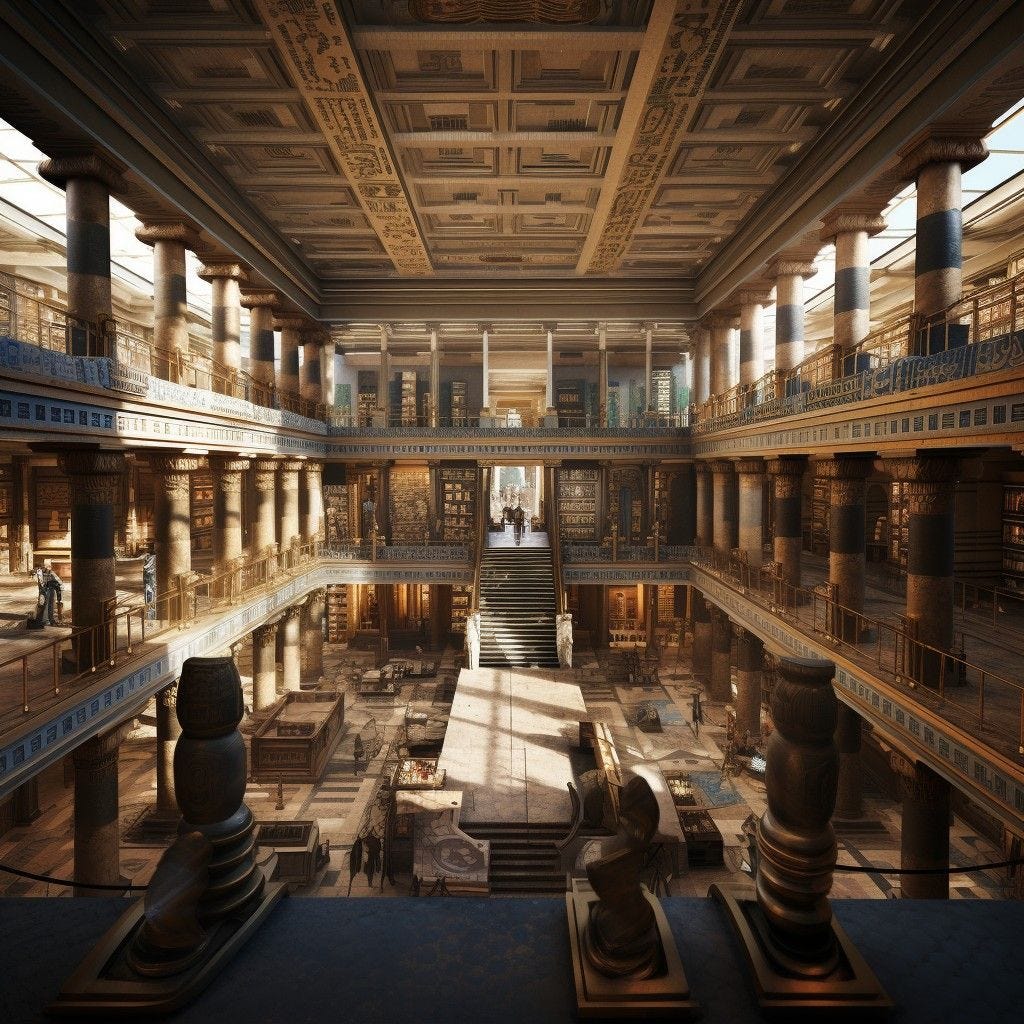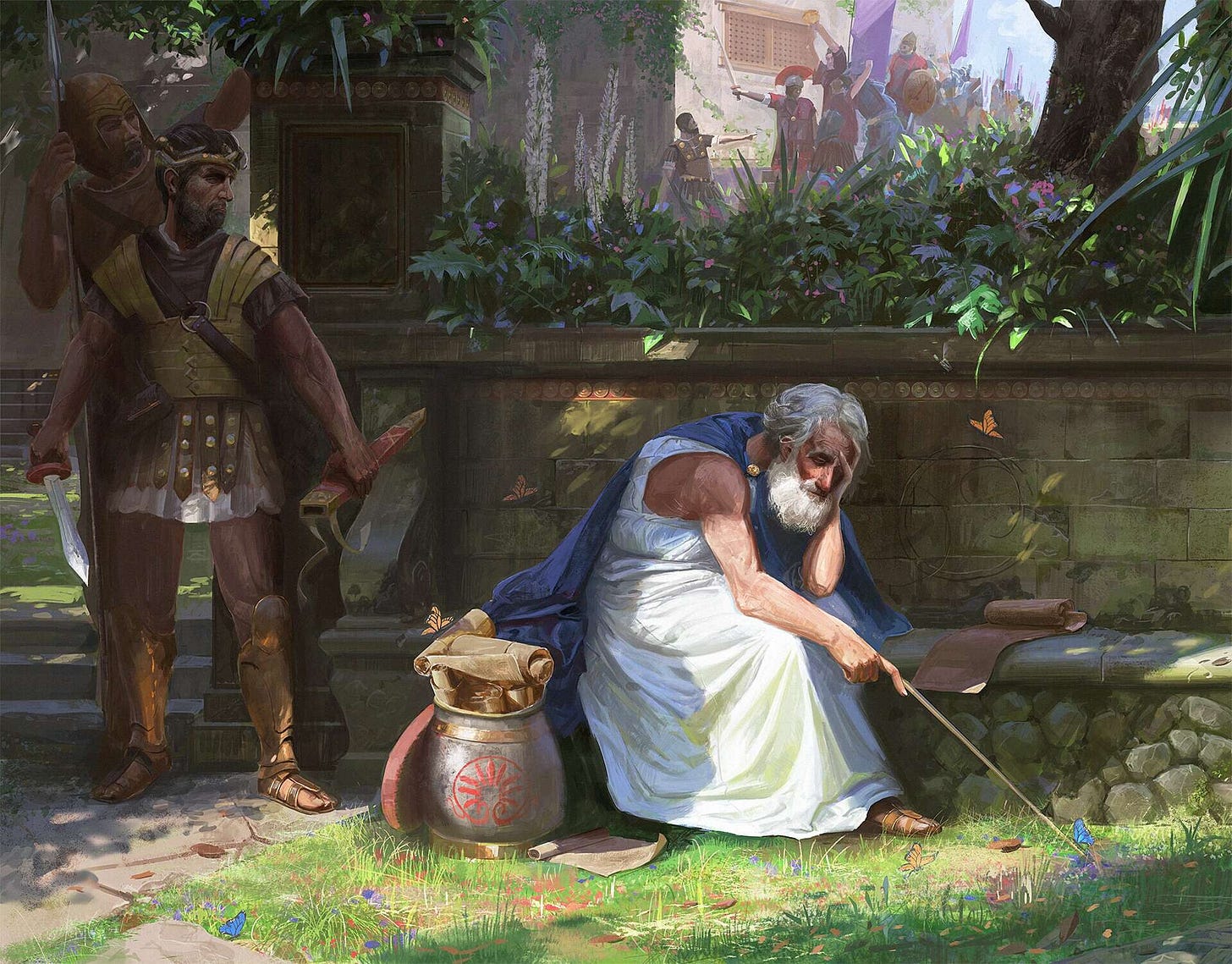Futuristic Cities of the Past
Hellenistic Visions That Shaped Tomorrow
Feature Article by The Black Wolf. Subscribe to his Substack here:
Before Paris or London ever dreamed of enlightenment, Alexandria lit its coastline with science. Syracuse weaponized mathematics. Pergamon turned knowledge into power. These weren’t just Greek cities; they were civilization’s laboratories.
From 323 BC, when Alexander’s death fractured his realm into successor kingdoms, to the Roman eclipse in 31 BC, these cities weren’t just settlements, they were audacious prototypes for tomorrow. Infused with a shared Hellenistic identity — koine Greek as the lingua franca, gymnasia pulsing with philosophical debates, and agoras buzzing with multicultural trade — these metropolises fused rationalist tech with mythic ambition.
They engineered harbors that tamed the seas, libraries that bottled human knowledge, and defenses that mocked mortality. Alexandria, Syracuse, and Pergamon stand as the triad of Hellenistic futurism: beacons of intellect, mechanics, and elevation that propelled a global movement, disseminating Greek science from the Nile to the Euphrates, seeding the intellectual soil for Rome’s aqueducts, Islamic golden ages, and our own silicon dreams.
In an era before blueprints or bytes, these cities dreamed in marble and mechanism, proving that Hellenism was less a culture than a code for transcending limits.
Alexandria: The Lighthouse of Eternal Minds
Perched at the Nile Delta’s edge, Alexandria erupted from Alexander’s vision in 331 BC, a grid-planned marvel engineered by Dinocrates that married Egyptian fertility with Greek precision. Under the Greek dynasty of Ptolemies, it swelled to half a million inhabitants, its Hellenistic core a vibrant agora where shaved Egyptian priests sparred with bearded Athenian sophists over Euclid’s geometry.
This wasn’t mere Hellenization; it was a cultural hadron collider, where koine Greek wove Egyptian hieroglyphs into a universal script, birthing a diaspora that exported Greek drama to the Indus and imported Zoroastrian star-charts for Ptolemy’s Almagest. Alexandria’s futuristic vibe hummed in its infrastructure: the Heptastadion, a 1.25-kilometer causeway linking Pharos Island to the mainland, created twin harbors that funneled Mediterranean trade like a proto-logistics hub, their moles lined with cranes hoisting obelisks and grain sacks under sail-shadowed skies.
Yet Alexandria’s true tech singularity was the Pharos (Lighthouse – in Greek), rising 100 meters in tiers of white marble by 280 BC, a solar-powered sentinel before solar panels, its parabolic mirrors (fueled by wood fires and reflectors) beaming signals 50 kilometers out, guiding triremes through fog like an ancient GPS.
More profoundly, the Great Library and Mouseion complex embodied Hellenistic knowledge as a living algorithm: up to 700,000 scrolls archived in climate-controlled halls, scholars like Eratosthenes calculating Earth’s circumference (within 1% accuracy) via shadow-gnomons, and Hero of Alexandria prototyping steam turbines in pneumatic labs.
The city was a hotbed of mechanical innovation. Engineers built water pumps, automata, and geared devices like the Antikythera mechanism. Workshops near the harbor crafted bronze and iron tools, while the Mouseion hosted experiments with steam, air pressure, and hydraulics. Hero’s aeolipile likely spun in such a workshop, its steam jets hissing as onlookers marveled.
This wasn’t hoarding wisdom; it was a networked OS for empire, with copyists dispatched to Athens and Babylon to “liberate” texts, fostering breakthroughs in anatomy (Herophilus dissecting live hearts) and optics that prefigured telescopes. Alexandria’s significance rippled globally: as Ptolemaic capital, it globalized Hellenism, exporting engineers to Seleucid Syria and astronomers to Han China via Silk Road whispers.
In a world of oral epics, it invented the footnote, turning scattered Greek genius into a portable, scalable force—much like today’s open-source codebases, ensuring Hellenistic ideas outlived pharaohs and persisted in Baghdad’s House of Wisdom.
Syracuse: The Mechanical Bastion of the West
Across the Ionian Sea, Syracuse gleamed as Magna Graecia’s unyielding forge, a Sicilian powerhouse founded by Corinthian colonists in 734 BC but Hellenized anew under tyrants like Gelon and Hieron II in the 3rd century BC.
With 300,000 residents by its zenith, it pulsed with a rugged Hellenistic identity: Doric temples flanked by cosmopolitan bazaars, where Pythagorean mathematicians bartered theorems with Phoenician navigators, and theocratic kings patronized Theocritean idylls that romanticized rural Greek roots amid volcanic soils.
Syracuse’s tech-forward ethos was defensive Darwinism—besieged by Carthage and Rome, it evolved into a gadgeteer’s paradise, its orthogonal streets (hippodamus-planned) threading through quarried cliffs to a hexagonal inner harbor that doubled as a submarine dock, its sea-gates engineered to flood attackers like a hydraulic trap.
The city’s futuristic heartbeat thrummed through Archimedes, the Syracusan polymath whose 3rd-century BC inventions weaponized physics into spectacle. His Claw, a massive iron grapnel swung by counterweights to upend Roman quinqueremes, or the death-ray mirrors (bronze shields focusing sunlight to ignite sails) weren’t myths but modular prototypes, blending levers, pulleys, and parabolic math into asymmetric warfare that delayed Rome for two years. It is even said he made a Solar Death Ray (a laser beam of the time) to burn Roman ships.
Less martial was the Archimedean screw, a helical pump irrigating terraced olive groves with Nile-like efficiency, and the odometer, a geared cart tallying miles for military logistics, early precursors to irrigation drones and GPS trackers. Syracuse’s grand theater, hewn into Temenites Hill and seating 15,000, amplified this vibe with acoustic vaults channeling whispers across rows, a natural amphitheater where Euripides’ tragedies echoed Hellenistic humanism: man as measure, taming chaos through techne. Its significance for the global movement was martial and mercantile: as a bulwark against Semitic incursions, Syracuse funneled Greek colonists westward, its shipyards exporting triremes to Ptolemaic fleets and its alchemical forges (brass-casting for statues) inspiring Vitruvian engineering.
In the Hellenistic web, it was the Western node—proving Greek rationalism could fortify frontiers, its gadgets echoing in Leonardo’s notebooks and modern siege ethics.
Pergamon: The Vertical Citadel of Codified Dreams
In Anatolia’s mist-shrouded hills, Pergamon ascended like a Hellenistic Stairway to Heaven, reforged from a 7th-century BC Mysian village into an Attalid acropolis by 281 BC. Under Eumenes II, its 100,000 citizens embodied a syncretic Hellenism: Ionian Greeks debating Stoic ethics in gymnasia adorned with Galatian friezes, where Persian satraps yielded to Attalid kings who styled themselves as new Pericleses.
Terraced across a 335-meter escarpment, the city defied topography with cyclopean walls and aqueducts channeling Madra River waters into vaulted cisterns—a vertical ecosystem sustaining siege-proof luxury, its multi-level agora a gravity-defying agora where merchants haggled Attic vases for Celtic torcs.
Pergamon’s tech futurism scaled heights in both stone and substrate. The acropolis’s engineering — 20-meter retaining walls of polygonal masonry stacking temples, palaces, and a 10,000-seat theater (its 65-degree rake a vertigo-inducing helix) — prefigured Brutalist megastructures, with subterranean tunnels for steam-heated hypocausts warming marble floors like radiant underfloor systems.
The library’s 200,000 parchments, housed in a basilica-like hall, weren’t static; they innovated the medium itself. Circa 200 BC, embargoed from Egyptian papyrus, Pergamene tanners birthed vellum — limed calfskin scraped to translucence, yielding a foldable, erasable canvas that birthed the codex, compressing scrolls into portable tomes for Hellenistic couriers. This material revolution, alongside Galen’s vivisection labs in the Asclepieion (geothermal vapor baths and dream-incubation groves blending askesis with pharmacology), turned the city into a bio-digital archive, its herbal distilleries prototyping essential oils akin to modern pharma.
The Great Altar’s gigantomachy frieze, 120 figures in bas-relief chaos, immersed viewers in a narrative diorama, Hellenistic propaganda as augmented reality. For the global movement, Pergamon was the upward vector: Attalid patronage lured scholars from Athens, exporting parchment to Rome and botany to Bactria, while its victories over Galatians (immortalized in Pergamene sculptures) Hellenized the hinterlands, bridging Aegean rationalism with Oriental mysticism. It codified knowledge as climbable capital, influencing Byzantine codices and Carolingian revivals
Echoes in the Eternal Agora
These three — Alexandria’s luminous nexus, Syracuse’s geared garrison, Pergamon’s terraced tome — wove the Hellenistic tapestry into a global grid, where Greek paideia irradiated from Indus academies to Iberian outposts, tallying 50 million Hellenophones by 100 BC. Their tech wasn’t gadgetry for its own thrill but a covenant: engineering to exalt the polis as microcosm of cosmos, fostering a movement that birthed algebra in Alexandria’s scriptoria, calculus precursors in Syracuse’s screws, and democratic texts on Pergamon’s skins.
Rome plundered their marbles, but the code endured — in aqueducts veining Europe, steam whispers haunting Hero’s engines, vellum birthing the Bible. Today, as we blueprint arcologies and AI pantheons, these cities remind us: true futurism isn’t prediction, but the Hellenistic audacity to build bridges from myth to mechanism, inviting all to the agora of tomorrow. In their ruins, we glimpse not faded glory, but the blueprint of boundless becoming.



















Thanks for all this well presented info
Very cool article. I knew a lot of this stuff but haven't really seen it put together this way--nice!